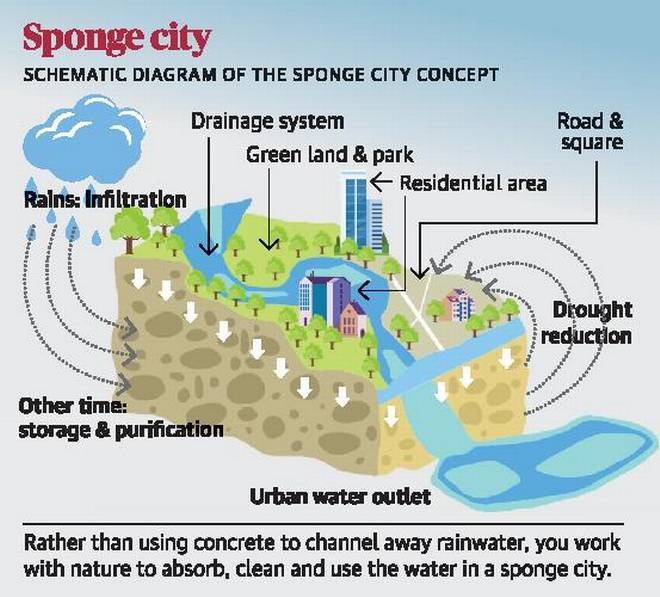Time for a sponge cities mission in India
Context
- The torrential rains in the third week of October in Hyderabad claimed the lives of over 50 people and hundreds of riverbed hutments were flushed away.
- The scale of destruction has been unprecedented and this experience is not unique to the city of Hyderabad but something that cities across India have been experiencing in recent years.
The case of Hyderabad- Reasons for urban flood
Unprecedented rainfall
- The rainfall received in 2020 has been the highest for the month of October in a century.
Inability to manage the city’s drainage systems
- The floods of October 2020 occurred because we did not discharge the water in time and when it was discharged it was in a sudden, uncontrolled manner.
Antiquated infrastructure
- Hyderabad’s century-old drainage system (developed in the 1920s) covered only a small part of the core city. In the last 20 years, the city has grown at least four times its original built-up area.
- As the city grew beyond its original limits, not much was done to address the absence of adequate drainage systems.
Incremental land use change
- Neglecting the issues of incremental land use change particularly of those commons which provide us with necessary ecological support — wetlands.
Sponge cities – Making cities permeable

- The most promising idea that mitigates flood risk and provides a pathway to water security appears to be the idea of “sponge cities”.
- The idea of a sponge city is to make cities more permeable so as to hold and use the water which falls upon it.
- Sponge cities absorb the rain water, which is then naturally filtered by the soil and allowed to reach urban aquifers. This allows for the extraction of water from the ground through urban or peri-urban wells. This water can be treated easily and used for city water supply.
- In built form, this implies contiguous open green spaces, interconnected waterways, and channels and ponds across neighbourhoods that can naturally detain and filter water.
- It implies support for urban ecosystems, bio-diversity and newer cultural and recreational opportunities.
- These can all be delivered effectively through an urban mission along the lines of the Atal Mission for Rejuvenation and Urban Transformation (AMRUT), National Heritage City Development and Augmentation Yojana (HRIDAY) and Smart Cities Mission.
What should the sponge cities mission address?
Wetland policy
- In most of our lakes, the shallow ends which are best characterised as wetlands often lie beyond the full tank level, have disappeared.
- Regardless of ownership, land use on even this small scale needs to be regulated by development control.
Watershed management and emergency drainage plan
- (A watershed is an area of land that drains or “sheds” water into a specific waterbody)
- This should be clearly enunciated in policy and law.
- Urban watersheds are micro ecological drainage systems, shaped by contours of terrain.
- Detailed documentation of these must be held by agencies which are not bound by municipal jurisdictions; instead, we need to consider natural boundaries such as watersheds instead of governance boundaries like electoral wards for shaping a drainage plan.
- The Metropolitan Development Authorities, National Disaster Management Authority, State revenue and irrigation departments along with municipal corporations should be involved in such work together.
Ban against terrain alteration
- Lasting irreversible damage has been done to the city by builders, property owners, and public agencies by flattening terrain and altering drainage routes.
- Thus terrain alteration needs to be strictly regulated and a ban on any further alteration of terrain needs to be introduced.
Change in nature of material used
- Our cities are becoming increasingly impervious to water, not just because of increasing built up but also because of the nature of materials used (hard, non-porous construction material that makes the soil impervious).
- To improve the city’s capacity to absorb water, new porous materials and technologies must be encouraged or mandated across scales which not only reduce run-off and the load on infrastructure, but also help keep water in the city for later use.
- Examples of these technologies are bioswales and retention systems, permeable material for roads and pavement, drainage systems which allow storm water to trickle into the ground, green roofs and harvesting systems in buildings.
We need to urgently rebuild our cities such that they have the sponginess to absorb and release water without causing so much misery and so much damage to the most vulnerable of our citizens.
Reference:
Subscribe
Login
0 Comments
